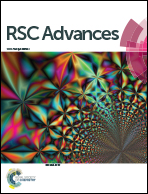Electrochemically reduced graphene oxide supported poly(indole-5-carboxylic acid) nanocomposite for genosensing application†
Abstract
In this paper, the poly(indole-5-carboxylic acid) (PICA) was electropolymerized on a pre-obtained electrochemically reduced graphene oxide (ERGNO) membrane to develop a novel direct DNA electrochemical biosensor. Due to the unique properties of graphene, conjugated indole-5-carboxylic acid (ICA) monomers tended to be adsorbed on the graphene plane by π–π* stacking and the electropolymerization efficiency was greatly improved, resulting in an enhanced electrochemical response of PICA. The obtained conjugated PICA/ERGNO nanocomposite not only served as a substrate for DNA immobilization but also reflected the electrochemical transduction originating from DNA immobilization and hybridization without any complicated labeling or outer indicators. The immobilization of the probe ssDNA was successfully conducted via noncovalent assembly ascribed to the π–π* interaction between the conjugated nanocomposite and DNA bases. After the hybridization of the probe ssDNA with the target DNA, the formation of double-helix structure induced the resulted dsDNA to be released from the surface of the conjugated nanocomposite, accompanied with the self-signal regeneration of the nanocomposite (“signal-on”). The dynamic range of this DNA biosensor for detecting the complementary target of BCR/ABL fusion gene from chronic myelogenous leukemia was from 1.0 × 10−16 to 1.0 × 10−9 mol L−1 using electrochemical impedance spectroscopy, and the detection limit was 2.3 × 10−17 mol L−1.


 Please wait while we load your content...
Please wait while we load your content...